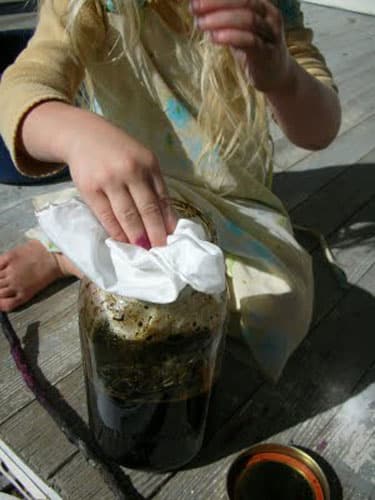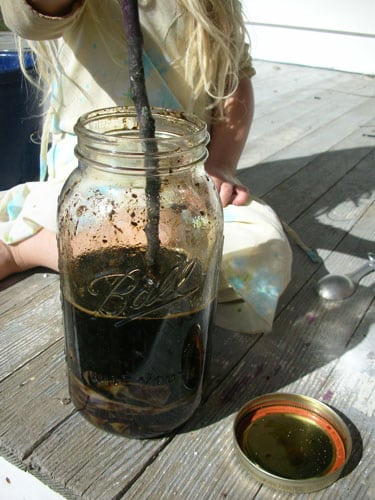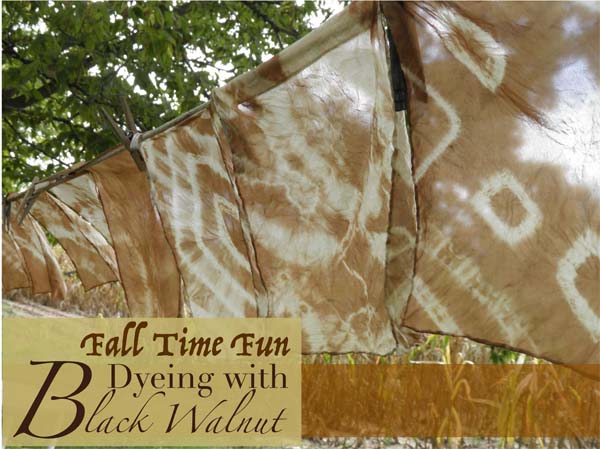“Without continuous hands-on experience, it is impossible for children to acquire a deep intuitive understanding of the natural world that is the foundation of sustainable development. ….A critical aspect of the present-day crisis in education is that children are becoming separated from daily experience of the natural world, especially in larger cities.”
-Natural Learning, Creating Environments for Rediscovering Nature’s Way of Teaching, Robin C. Moore and Herb H. Wong
One of the funnest activities for us around here is dyeing with plants. We tried using St. John’s Wort, Pokeberries, Goldenrod, Prunella, Dandelion, Wild Cherry, Turmeric, Black Walnut and many more but hands down, Black Walnut is our favorite plant dye!
The great thing about Black Walnuts is how easy it is to use as a dye. Black Walnut dye is colorfast and needs no mordanting to become colorfast. Simply add water and heat. Over the years we’ve tried different methods with great results each time.
We often gather white clothes from thrift shops throughout the year for dyeing when the Black Walnut hulls start falling from the trees. Any natural fabric works such cotton, wool, silk, hemp or linen. Off white or light colored natural materials will dye well too.
The first method for making a dye is to put Black Walnut hulls (green or black) or leaves into a half gallon or gallon jar and fill with water. Screw the lid on and let it sit in the sun for 5 – 7 days. Green hulls give different colors than black ones, the green giving a more golden appearance while the black is a more taupe-ish brown. Leaves often give a more olive drab color.
The second method is quicker, simply fill a stockpot about half full of the hulls or leaves add water to completely cover and simmer on the stove for an hour. The longer you let it steep, the darker it will get.
To prepare your items for dyeing, wash them through a normal wash cycle if they are brand new. If they are used, pre-washing is not necessary.
Decide how you want your items to look. If you bind them tightly with twine or rubber bands, the results will be lines and streaks or various tie dye effects depending on how you bind them. I love to carefully fold up the fabric then tightly bind it with thin cotton or hemp twine. The result is streaks with lines through them, reminiscent of trees.
If you don’t prefer special effects, you can place your fabric directly in to the pot and get a solid dye. Be sure to remove the hulls first or you may get some mottling (which is also another nice effect).
Once your dye baths are ready, strain off the liquid and set it aside. Compost the hulls. If there’s enough room, you may wish to leave the hulls in for a mottled effect.

Return the dye bath back to the pot or jar and add your fabrics. For the sun dyeing method, place the sealed jar back into the sun for an additional 5 – 7 days. For the stove top method, return the pot to the stove and bring it back to a simmer. Turn off the heat and let the dye bath sit for 30 minutes – 2 hours. The longer it sits, the darker it gets.

Once you are done dyeing, use tongs to remove the article from the stock pot if you want to save the dye bath for a second round. If not, dump the entire pot into the sink. Run cool water over the items until they are cool enough to touch then start squeezing out the dye and water until the water runs clear. If you are using the sun method, follow the same procedure but there’s no need to worry about the hot dye bath.

When your items are clear of any leftover dye, hang them on the line or dry in a dryer. The color is set and can be washed with like colored items.


Have you ever used Walnut hulls or other plants to dye with? We’d love to see pictures of your dyed items, post them on our Facebook page! And if you try this for the first time, let us know how you like the outcome (and share your pictures with us)!

